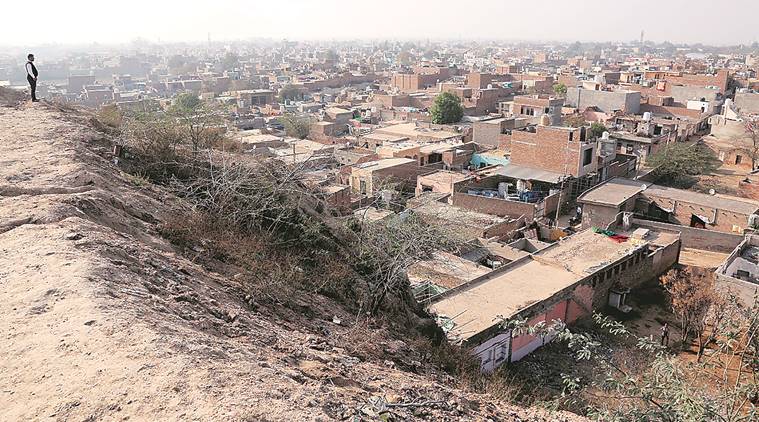 In a report to the government in January, Sirsa Deputy Commissioner Ramesh Chander Bidhan admitted, “A few have conveyance deeds of the protected government land in their favour.”
In a report to the government in January, Sirsa Deputy Commissioner Ramesh Chander Bidhan admitted, “A few have conveyance deeds of the protected government land in their favour.”
A mound in Sirsa indistinguishable from the dusty background of most Haryana small towns could hold clues to the ancient city of ‘Sarishika’. Falling on the old route to Takshashila, the 6th-5th century BC city found mention in the Mahabharata, Panini’s Ashtadhyayi and the Buddhist text Divyavadana.
However, before the Archaeological Survey of India (ASI) can confirm the historicity of the site, it has to convince the nearly 50,000 people living on the identified 82 acres to move. With 788 families forcibly rehabilitated three years ago following a high court order still struggling for basic amenities, the residents, many of whom settled here following Partition, are not willing to move.
They also accuse the authorities of letting the situation fester, with a 1904 Ancient Monuments Preservation Act first declaring Sirsa’s ‘Ther Mound’, which rises 15-18 metres above nearby areas, a protected monument back in July 1932.
There is also a dispute over the size of the protected area, with surveys by the ASI and government departments such as Revenue and Archaeology and Museums coming up with different figures.
Over the years, the inhabitants, who have formed a forum called the Apna Ghar Bachao Sangharsh Samiti, have acquired documents, including land conveyance deeds, sale-purchase agreements, municipal tax receipts, electricity and water meter connections which, they point out, can’t be issued to “encroachers”. Attempts to evict them have seen protests, clashes with security personnel, and multiple petitions in the Punjab and Haryana High Court.
In a report to the government in January, Sirsa Deputy Commissioner Ramesh Chander Bidhan admitted, “A few have conveyance deeds of the protected government land in their favour.”
The government is said to be trying to see if the ASI can take the parts of Ther that are heavily inhabited out of the protected zone.
Zulfequar Ali, the ASI Superintending Archaeologist in-charge of the mound, said they carried out the initial excavation in 2018-19 after the first round of rehabilitation. “We wanted to ascertain the antiquity of the site and the nature of a fort believed to be lying underneath. In the three months that we got for excavation and scraping of the mound, we found numerous antiquarian remains, ranging from the Gupta to the Mughal period. But we need more area and more time, and need to go deeper.”
The Gupta period (mid-to-late 3rd century CE to 543 CE) is considered a Golden Age and covered much of the Indian subcontinent.
The High Court got into the picture after a plea was filed in 1997, and in successive orders, directed the Centre as well as Punjab and Haryana to submit a list of their protected monuments, while asking the ASI and respective deputy commissioners to retrieve these from encroachers. In 2016, the court stalled a bid by Haryana to “de-notify” the Ther land as protected.
The next hearing is due this week.
Deepak Phutela, a sweet shop owner who has a four-storey house on the Thed Mound, said this was the third generation of his family settled here. “Thousands of homeless people came here after 1947 from Western Pakistan,” he said.
Jagjit Singh, a Councillor of Ward No. 19 under which most of Ther falls, accused the Sirsa administration of “erring repeatedly”. He also claimed that the protected site “should not be more than 31 acres”. “But one Deputy Commissioner declared 82 acres, including land surrounding the actual mound,” Singh said.
However, following the officer’s affidavit to court in that regard, a joint survey conducted by the ASI and Haryana’s Archaeological and Museums Department too had put the Ther area at 82 acres.
The authorities are apprehensive of any forcible action as the area includes politically sensitive Gujjar and Valmiki Mohallas. Previous attempts to even paste show-cause notices of eviction have seen violent protests and manhandling of officials.
Said one resident of Valmiki Mohalla, refusing to be identified, “How can anybody knock at our doors one day and say we are encroachers? Was the government sleeping when people built their houses?… When they need votes, they come to us. After winning, they come with bulldozers.”
“We have submitted a status report to the state government. Since the matter is in the High Court, it is not appropriate for me to share any more details. But, we are on the job,” Deputy Commissioner Bidhan told The Indian Express.
The state of the families shifted out of Ther in 2017 is adding to the resistance. Totalling 788, the families of mostly daily wagers were rehabiliated in two-room flats of a Sirsa Housing Board colony around 8 km away. Three years later, the colony still has no proper sewerage system, outer walls are covered with algae and doors of many flats have crumbled due to termites.
“Is this the rehabilitation the government talks about? We were dumped here like animals, and no government functionary came to take another look,” said Sunil Kumar, among the first to be moved to the colony. Pointing to a water pump surrounded by sewage, he said, “Can even an animal drink this water?”
According to him, he had bought his land at Ther for Rs 22,000, from a man who sold plots to many others. “All we are left with are stamp papers. What do we do now with this trash?”
Sonu, who said it was his great grandfather who first moved to Ther, said living in the colony had added to their expenses, with commute alone costing Rs 50 daily.